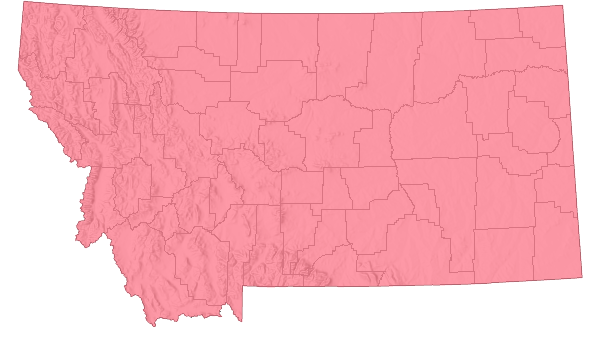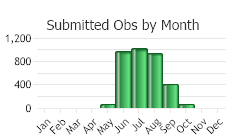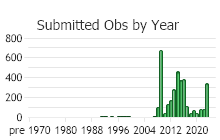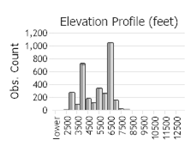View in other NatureServe Network Field Guides
NatureServe
Montana
Utah
Wyoming
Idaho
Wisconsin
British Columbia
South Carolina
Yukon
California
New York
Hoary False-alyssum - Berteroa incana
Other Names:
Hoary False Madwort, Hoary Alyssum
State Rank Reason (see State Rank above)
Berteroa incana is a plant native to Europe and introduced into North America (Lesica et al. 2012). A conservation status rank is not applicable (SNA) because the plant is an exotic (non-native) in Montana that is not a suitable target for conservation activities.
General Description
PLANTS: Annuals with erect, branched stems and 20–75 cm tall. Plants are densely hairy with star-shaped, appressed trichomes (stellate pubescence) that give it a gray appearance. Source: Lesica et al. 2012.
LEAVES: Basal leaves have petioles, are widest near their tip (oblanceolate) with entire (smooth) margins, and whither by flowering. Stem leaves are sessile, oblanceolate, 1–3 cm long, and grow erect but become reduced upwards. Source: Lesica et al. 2012.
INFLORESCENCE: A narrow, simple or compound, many-flowered raceme. Flowers consist of 4 green sepals with white margins of 2–3 mm long and 4 white petals of 4–6 mm long. Petals are narrow at the base, flare upwards, and are deeply notched, and may appear 8-petalled. Sources: Lesica et al. 2012; Parkinson et al. 2017.
Berteroa is named for Carlo Giuseppe Bertero, 1789-1831, an Italian physician and botanist who settled in Chile (FNA 2003). The common name of Hoary False-alyssum references the plant’s grayish appearance from stellate hairs (hoary) and its original treatment by Carl Linnaeus who placed it in the genus Alyssum.
Phenology
Flowering May through September (FNA 2003).
Diagnostic Characteristics
There are many white-flowered members of the Mustard Family, both native and exotic. It is recommended that identifications be made using a plant manual designed for Montana. Mustards have flowers with 4 sepals, 4 petals, and 6 stamens (4 long and 2 short) among other characteristics.
Hoary Alyssum –
Berteroa incana, exotic and Noxious:
* White-flowered, annual plants that grow from taproots and have mature silicles (fruits) that are not notched at their tip.
* Each of the 4 petals are notched, making the flower appear 8-petaled.
* Plants have star-shaped hairs; whereas,
Lepidium species have simple hairs or none.
* Stem leaves are widest near their tip (oblanceolate), sessile on the stem, and point upwards.
Field Pennycress –
Thlaspi arvense, exotic:
* White-flowered, annual plants that grow from taproots and have mature silicles (fruits) that are large, deeply notched at their tip, flat, and with very wide wings, resembling a penny.
* Lower stem leaves have petioles. Upper stem leaves are sessile, clasping, auriculate (lobed like an arrow), and with smooth to toothed margins.
Little Seed False Flax –
Camelina microcarpa, exotic:
* Pale yellow-flowered, annual plants that grow from taproots and have mature silicles that lack a notch, lack hairs (glabrous), have a style (beak) of 5-7 mm long and a stalk of 9-15 mm long.
* Plants have simple or branched hairs, but not star-shaped hairs.
Perennial Pepperweed –
Lepidium latifolium, exotic and Noxious:
* White-flowered plants that grow from creeping roots (rhizomes) and have mature silicles (fruits) that are not notched at their tip.
* White petals are not notched.
* Silicles are glabrous or sparsely pilose (long soft hairs) with a very short style of 0.1 mm long or less. Silicle stems (pedicels) are 2-5 mm long.
* Stem leaves are sessile, but do not clasp around the stem.
Whitetop –
Lepidium draba, exotic and Noxious:
* White-flowered plants that grow from creeping roots (rhizomes) and have mature silicles (fruits) that are not notched at their tip.
* White petals are not notched.
* Silicles are glabrous (lack hairs), flattened, and their base is cordate (heart-shaped or indented). Silicles are tipped with a style of 1-1.5 mm long. Silicle stems (pedicels) are 5-12 mm long.
* Stem leaves are auriculate (lobed like an arrow) and clasping around the stem.
Common Yarrow –
Achillea millifolium, native and desirable:
* Member of the Aster or Sunflower Family.
* Bright-white flowers arranged closely in a flat-topped inflorescence.
* Leaves are 2-3 times pinnately dissected, appearing fern-like or bushy like a squirrel’s tail.
Sources: Jacobs and Mangold 2007; FNA 2010; Graves-Medley and Mangold 2011; Lesica et al. 2012.
Species Range
Montana Range
Range Descriptions

 Non-native
Non-native
Range Comments
Hoary False-alyssum is native to Europe (Lesica et al. 2012). It is thought to have come to North America as a contaminant in clover and alfalfa seed (Parkinson et al. 2017). In Montana it was first document in 1905 from Gallatin County (http://www.pnwherbaria.org). Long-distant dispersal mechanisms in North America are likely from contaminated hay, lawn, and other forage seed (Parkinson et al. 2017). Short-distant dispersal mechanisms are mostly likely from vehicles and farm equipment. By the 1950s to 1960s Hoary False-alyssum was receiving attention in the north-central U.S. where it increasingly was found in hay fields and pastures associated with drought, poor soil fertility, and/or overgrazed conditions (Parkinson et al. 2017).
For maps and other distributional information on non-native species see:
Nonindigenous Aquatic Species Database from the U.S. Geological Survey
Invasive Species Habitat Tool (INHABIT) from the U.S. Geological Survey
Invasive Species Compendium from the Centre for Agriculture and Bioscience International (CABI)
EDDMapS Species Information EDDMapS Species Information
Observations in Montana Natural Heritage Program Database
Number of Observations: 3862
(Click on the following maps and charts to see full sized version)
Map Help and Descriptions
Relative Density

Recency



 (Observations spanning multiple months or years are excluded from time charts)
(Observations spanning multiple months or years are excluded from time charts)
Habitat
Hoary False-alyssum commonly grows in fields, along roadways, on trails, and along gravelly banks of streams and lakes in the plains, valleys, and montane areas of Montana (Lesica et al. 2012; Parkinson et al. 2017).
Ecology
Hoary False-alyssum are pollinated by small insects. Particular Syrphid and other flies (Diptera), wild bees, and wasps (Hymenoptera) are able to access the shallow nectaries in the small flowers.
Hoary False-alyssum is adapted to the temperate continental climate characterized by cold winters and hot, dry summers (Parkinson et al. 2017). It thrives on dry and disturbed ground composed of coarse limestone and calcareous soils with poor nutrients. Across 5 sites in southwest Montana soil sandiness ranged from 50% to 80%.
Germination is limited by moisture while growth is limited by light (Parkinson et al. 2017). In the open plants can grow larger and produce more flowers and seeds compared to those growing in vegetated areas.
NUTRITION
Mature Hoary False-alyssum plants are low in crude protein and digestible carbohydrates. Hay fields with at least 30% of Hoary False-alyssum produces forage that is toxic to horses causing laminitis, limb edema, diarrhea, intravascular haemolysis, and hypovolemic shock. Hay containing 30% to 70% of Hoary False-alyssum have killed horses. Hoary False-alyssum mixed with alfalfa can remain toxic for up to 9 months.
Reproductive Characteristics
Hoary False-alyssum reproduces only by seed (Parkinson et al. 2017).
FRUITS Sources: Lesica et al. 2012; Parkinson et al. 2017
Silicles (fruits) are elliptic, inflated, 4–7 mm long, and covered with star-shaped (stellate) hairs. At maturity fruits retain the 1-2 mm long style (at their tip) and have a stalk (pedicel) of 4–7 mm long. Silicles have two chambers where seeds develop. The chambers are separated by a clear membrane that remains on the plant after seeds disperse. In each chamber 3-7 (12) seeds develop, are lens-shaped with narrow marginal wings, 1-1.5 mm long, and dark reddish-brown at maturity.
LIFE CYCLE [Adapted from Parkinson et al. 2017]
Annual plants complete their life cycle in one growing season. Seeds germinate from early spring to late fall. Germination and growth are limited and are limited by moisture. Seedlings that establish by July or earlier can produce seed by early fall. Seedlings that establish in late July or later will over-winter as rosettes and produce flowers and seeds the following spring. It is assumed that most seed disperses close to the parent plant; however, the light-weight and wings of the seed could allow them to be dispersed by wind and/or water.
Plants in the rosette stage can accumulate non-structural carbohydrates (sugars) in their roots until the first hard frost. These stored carbohydrates are needed to have winter hardiness and to use for respiratory maintenance during dormancy and to grow after breaking dormancy. Thus, rosette plants can over-winter while flowering plants which cannot accumulate stored carbohydrates are not capable of surviving through winter.
Hoary False-alyssum seeds can remain dormant and viable for about nine years, thus developing its own seed bank. At 6 sites in southwest Montana, Hoary False-alyssum produced from 0 to 5,632 seeds per plant, averaging 584 +/- 184 seeds per plant. Seed viability varied from 32% to 78% with an average viability of 53% +/- 4%.
Management
An integrated vegetative management approach provides the best long-term control, and requires that land-use objectives and a desired plant community be identified (Shelly et al.
in Sheley and Petroff 1999). Once identified an integrated weed management strategy can be developed to promotes a weed-resistant plant community and serves other land-use objectives such as livestock forage, wildlife habitat, or recreation can be developed, making control of Hoary False-alyssum possible.
Plants are easily spread across long distances in contaminated hay, lawn, and other forage seed and across short distances by vehicles, farm equipment, and animal grazing (Parkinson et al. 2017).
PREVENTION [Adapted from Parkinson et al. 2017]
Seed development must be prevented to reduce or stop spread. Spread can be prevented or reduced by:
* Preventing vehicles from driving through and animals from grazing within infested areas,
* Thoroughly wash the undercarriage of vehicles and wheels in a designated area before moving to an uninfested area,
* Encouraging landowners to frequently monitor their land for new infestations and, when found to implement effective control methods.
* Maintain proper livestock grazing management that is more resilient to Hoary False-alyssum invasion, and
* Developing educational campaigns to teach people to not pick and transport the white flowers.
PHYSICAL and CULTURAL CONTROLS [Adapted from Parkinson et al. 2017]
Hand-pulling is effective because the plants are annuals with shallow taproots. Plants should be pulled when soil is moist to better extract the entire root; roots that remain in the soil could re-generate. Hand-pulling needs to occur repeatedly until the seed bank is depleted. Plants with seeds should be burned if conditions permit or sealed in plastic to desiccate or rot before disposing into the trash
Mowing will not control Hoary False-alyssum and does remove other plants that could shade-out or compete against it. Mowing also disperses seeds. In certain situations and when combined with irrigation and nutrient management mowing to a 6-inch stubble height could increase the vigor of desirable plants that would shade-out and reduce Hoary False-alyssum seed production.
Mowers must be carefully and thoroughly cleaned to prevent spreading seeds.
Shallow
Tilling that severs the tap root below the root crown will kill plants and increase seed germination. Therefore, repeated tilling should occur to deplete the seed bank. Alternatively, tilling in combination with other treatments (example, hand-pull, herbicide, revegetation) can control Hoary False-alyssum.
Prescribed Burning can kill plants and seed if done before silicles open. However, burning exposes soils and creates a high light condition that might be conducive for invasion. Fire in combination with other treatments might be useful. An integrated weed management plan and diligent monitoring is necessary to develop an effective plan.
Revegetation is effective at controlling Hoary False-alyssum plants and seed production. Sustainable suppression requires revegetation with desireable plants that compete well for light, water, and nutrients. Desirable vegetation should be appropriate for the management objectives, adapted to the site conditions, be competitive. Planting with appropriate native plants is highly encouraged. Refer to Montana Plant Materials Technical Note 46,
Seeding Rates for Conservation Species for Montana, and Extension Bulletin EB0019,
Dryland Pasture Species for Montana and Wyoming for possible species selection and seeding rates.
Irrigation and
Fertilization can be used to increase production of other plants because Hoary False-alyssum prefers drier conditions and thrives on sites with poor soil fertility. Used together proper irrigation and nutrient management can prevent invasion or reduce infestations. However, these treatments should also be appropriate for the site conditions and land management objectives. Revegetation should also likely be included in the treatment plan.
CHEMICAL CONTROLS [Adapted from Parkinson et al. 2017]
As of 2018 few herbicide formulations list Hoary False-alyssum on their labels. For up to date information on herbicides, consult
Greenbook.
For control in rangelands and grass pastures products that contain the active ingredient
Metsulfuron-Methyl can be effective. An anecdotal report suggests that
2,4-D at the rate of 1 quart per acre provides effective and economical control in rangelands and pastures.
As of 2018 there are no broadleaf herbicides labeled for control of Hoary False-alyssum on grass/legume mixed pastures because these chemicals can harm legumes. For highly disturbed areas with Hoary False-alyssum
Glyphosate applied at 1-2 quarts per acre controls all plants, but must be followed with a revegetation plan.
It is often standard to apply herbicides to actively growing plants before they bolt. The research in southwest Montana found that several herbicides decreased Hoary False-alyssum seed production and viability across various growth stages from early to late flowering.
GRAZING CONTROLS [Adapted from Parkinson et al. 2017]
Hoary False-alyssum establishes and reproduces best in overgrazed land; therefore, proper grazing management techniques that maintain the competitiveness of forage plants is necessary.
In general grazing animals have not been used to control Hoary False-alyssum. Cattle can eat Hoary False-alyssum, but will generally select for more digestible plants. In a study goats were found to select for weed-free hay more than for hay mixed with Hoary False-alyssum. In a forage field study conducted in Minnesota, lambs rejected Hoary False-alyssum. In sufficient quantities Hoary False-alyssum is toxic to horses (refer to the Ecology Section).
BIOLOGICAL CONTROL [Adapted from Parkinson et al. 2017]
Currently no biological control agents are available.
Useful Links:Montana Invasive Species websiteMontana Biological Weed Control Coordination ProjectMontana Department of Agriculture - Noxious WeedsMontana Weed Control AssociationMontana Weed Control Association Contacts Webpage.
Montana Fish, Wildlife, and Parks - Noxious WeedsMontana State University Integrated Pest Management ExtensionWeed Publications at Montana State University Extension - MontGuidesStewardship Responsibility
Threats or Limiting Factors
Hoary False-alyssum decreases forage value for livestock because of its poor nutritional content. Hay mixed with at least 30% Hoary False-alyssum is toxic to horses and could cause mortality [See Ecology section].
References
- Literature Cited AboveLegend:
 View Online Publication
View Online Publication Lesica, P., M.T. Lavin, and P.F. Stickney. 2012. Manual of Montana Vascular Plants. Fort Worth, TX: BRIT Press. viii + 771 p.
Lesica, P., M.T. Lavin, and P.F. Stickney. 2012. Manual of Montana Vascular Plants. Fort Worth, TX: BRIT Press. viii + 771 p. Sheley, Roger, and Janet Petroff. 1999. Biology and Management of Noxious Rangeland Weeds. Oregon State University Press, Corvallis, Oregon.
Sheley, Roger, and Janet Petroff. 1999. Biology and Management of Noxious Rangeland Weeds. Oregon State University Press, Corvallis, Oregon.
- Additional ReferencesLegend:
 View Online Publication
View Online Publication
Do you know of a citation we're missing? Law, D.J. 1999. A comparison of water table dynamics and soil texture under black cottonwood recent alluvial bar, beaked sedge, and Geyer's/Drummond's willow communities. M.Sc. Thesis. Bozeman, MT: Montana State University. 68 p.
Law, D.J. 1999. A comparison of water table dynamics and soil texture under black cottonwood recent alluvial bar, beaked sedge, and Geyer's/Drummond's willow communities. M.Sc. Thesis. Bozeman, MT: Montana State University. 68 p. Lesica, P., M.T. Lavin, and P.F. Stickney. 2022. Manual of Montana Vascular Plants, Second Edition. Fort Worth, TX: BRIT Press. viii + 779 p.
Lesica, P., M.T. Lavin, and P.F. Stickney. 2022. Manual of Montana Vascular Plants, Second Edition. Fort Worth, TX: BRIT Press. viii + 779 p. Meier, G.A. 1997. The colonization of Montana roadsides by native and exotic plants. M.Sc. Thesis. Bozeman, MT: Montana State University. 45 p.
Meier, G.A. 1997. The colonization of Montana roadsides by native and exotic plants. M.Sc. Thesis. Bozeman, MT: Montana State University. 45 p. Menalled, U.D., S.C. Davis, and J.M. Mangold. 2018. Effects of herbicide management practices used by invasive plant managers on Berteroa incana (Hoary Alyssum) seed biology and control. Invasive Plant and Science Management 11(2):101-106.
Menalled, U.D., S.C. Davis, and J.M. Mangold. 2018. Effects of herbicide management practices used by invasive plant managers on Berteroa incana (Hoary Alyssum) seed biology and control. Invasive Plant and Science Management 11(2):101-106. Olliff, Tom, Roy Renkin, Craig McClure, Paul Miller, Dave Price, Dan Reinhart, and Jennifer Whipple. 2001. Managing A Complex Exotic Vegetation Program in Yellowstone National Park.
Olliff, Tom, Roy Renkin, Craig McClure, Paul Miller, Dave Price, Dan Reinhart, and Jennifer Whipple. 2001. Managing A Complex Exotic Vegetation Program in Yellowstone National Park. Quire, R.L. 2013. The sagebrush steppe of Montana and southeastern Idaho shows evidence of high native plant diversity, stability, and resistance to the detrimental effects of nonnative plant species. M.Sc. Thesis. Bozeman, MT: Montana State University. 124 p.
Quire, R.L. 2013. The sagebrush steppe of Montana and southeastern Idaho shows evidence of high native plant diversity, stability, and resistance to the detrimental effects of nonnative plant species. M.Sc. Thesis. Bozeman, MT: Montana State University. 124 p. Sater, S. 2022. The insects of Sevenmile Creek, a pictorial guide to their diversity and ecology. Undergraduate Thesis. Helena, MT: Carroll College. 242 p.
Sater, S. 2022. The insects of Sevenmile Creek, a pictorial guide to their diversity and ecology. Undergraduate Thesis. Helena, MT: Carroll College. 242 p. Seipel, T.F. 2006. Plant species diversity in the sagebrush steppe of Montana. M.Sc. Thesis. Bozeman, MT: Montana State University. 87 p.
Seipel, T.F. 2006. Plant species diversity in the sagebrush steppe of Montana. M.Sc. Thesis. Bozeman, MT: Montana State University. 87 p.
- Web Search Engines for Articles on "Hoary False-alyssum"





